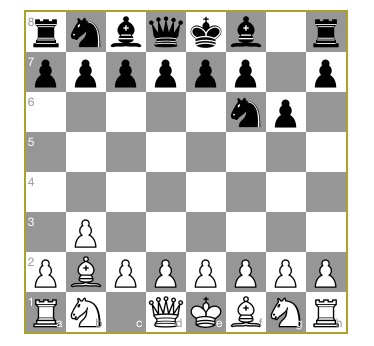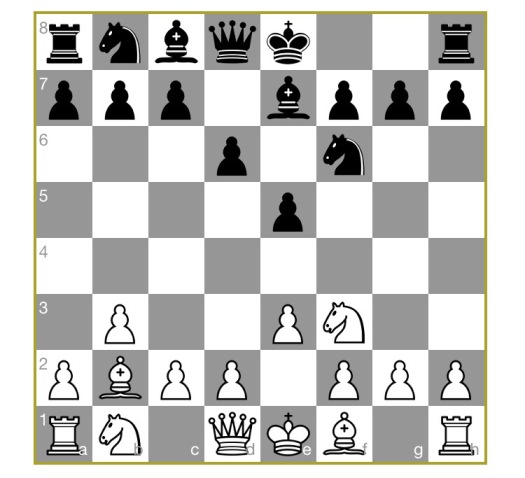Hello ChessJournal fans!
Whilst everyone anxiously waits for the upcoming launch of ChessJournal Pro (well I know I’m excited anyway), I thought I would write a quick blog post on my favourite opening, Larsen’s Attack or 1.b3.
I’ve made no secret that this is my go to opening in all formats of our great game and yes I am sure some people reading this are already rolling their eyebrows! As a Class A amateur chessplayer (circa 1800 – 1825) I don’t consider myself an authority on openings (I certainly won’t be blogging on “how to play Larsen’s attack”) but I will say two things on this wonderful opening:
- It is theoretically sound.
- Amateur club chessplayers haven’t got a clue how to respond.
I have been playing Larsen’s opening for almost 6yrs in the local league and have kept a record of my results and the types of setup that my opponents responded with. It is these statistics that I thought were most interesting to your average wood pusher and the reason for writing this blog post.
Obviously my results are not always decided in the opening but I feel there is a reasonable sample size (60 Games) to enable us to draw some conclusions.
For me, the biggest interest is in comparing how amateur chessplayers respond to 1.b3 compared to professionals. First of all let’s compare black’s first move choice:
Amateurs First Move Responce to 1.b3 (Professional stats in brackets taken from ChessBase)
- 1…e5: 33% (44%)
- 1…d5: 15% (25%)
- 1…c5: 12% (5%)
- 1…nf6: 22% (16%)
- 1…other: 18% (10%)
So we can see that club players are typically shying away from creating a large centre when confronted with 1.b3. The obvious central pawn pushes occurring only 48% of the time compared to 69% of the time in professional matches. Perhaps this conservatism also explains the higher likelihood of 1…nf6. Now let’s look at setups.
How Amateur Chess players setup against 1.b3
When studying and learning Larsen’s Attack I have effectively grouped Black’s setups into 6 setups (percentages show how often I have faced these setups):
- “Big Centre” (12%): Black pushes both central pawns forward two squares and challenges White in a classical fashion;
- “Little centre” (22%): Black plays e5 and a subsequent d6. A Pirc style set up;
- “Slav” (3%): Black plays d5, c6 and e6 (with his white bishop inside or outside the pawn chain);
- “Reversed Nimzo Indian” (23%): Black plays c5, d5 and e6.
- “Indian” (22%): Black plays nf6, g6 and bg7.

- “Other” (18%): Black plays literally anything else such as 1. a5 I have faced on a number of occasions!
As you would expect from such a passive start as 1. b3 there is a varied responce from amateur chess players with no clear winner of an opening responce. However, what you do see is a clear push to more quieter setups, almost certainly as a result of being taken off guard early on. Only 12% of amateur chess players have dared to create a big centre against me in 6yrs!
Finally in the spirit of complete honesty I have broken down my performance against these different setups below:
- “Big Centre”: 43%
- “Little Centre”: 38% (ouch!)
- “Slav”: 100% (only two games)
- “Reversed Nimzo- Indian”: 64%
- “Indian”: 58%
- “Other”: 64%
- TOTAL: 56%
As I said before, the game is not nessesserily won or lost in the opening but there does appear to be a clear difference in my results compared to my opponents decision to push the e pawn two squares. When my opponent plays e5 I typically score 40%. When they don’t push e5 and choose a different setup I typically score 64%!
So maybe the professional criticism of 1.b3 (as opposed to the Nimzo-Larsen Attack with 1.nf3, stopping e5) is right after all? Or maybe I just know where I need to study 🙂
So there we are! I hope you have found these statistics interesting. I am fascinated in the discrepancies between amateur play and professional. I hope any club players interested in 1.b3 find this article useful, if only to understand where to focus your efforts. My opponents ratings in this sample of amateur games typically range between 1600 and 2000 so very typical of an average club level.
In other news, ChessJournal Pro is ticking along nicely and we are still planning an April launch. I really can’t emphasise how excited I am! I personally have been beta testing the new app for the last week and am loving it (ok I’m bias I know).
Until next time, thanks for reading!
Jon
ChessJournal is the companion app for club and tournament players. Store your games in the cloud for free and analyse them on the go on your phone or tablet. Leave your laptop at home the next time you visit that big tournament!
You can download ChessJournal on iOS and Android here:









I enjoyed your article, thank you.
I am playing this too but tend strongly towards 1.Nf3.
Your stats are fascinating to consider.
I do not know my exact numbers but I am doing very well with this opening, too.
I have tried being more aggressive as white but nothing works well. Recently, I tried the Catalan and that was definitely not my style!
Since I look for consistency and simplicity to lessen my work on the openings I am playing the Nimzo and Queen’s Indian vs 1.d4 and the French vs 1.e4. The pawn structures and piece placement seem familiar across all of these.
Good luck and thanks again
LikeLike